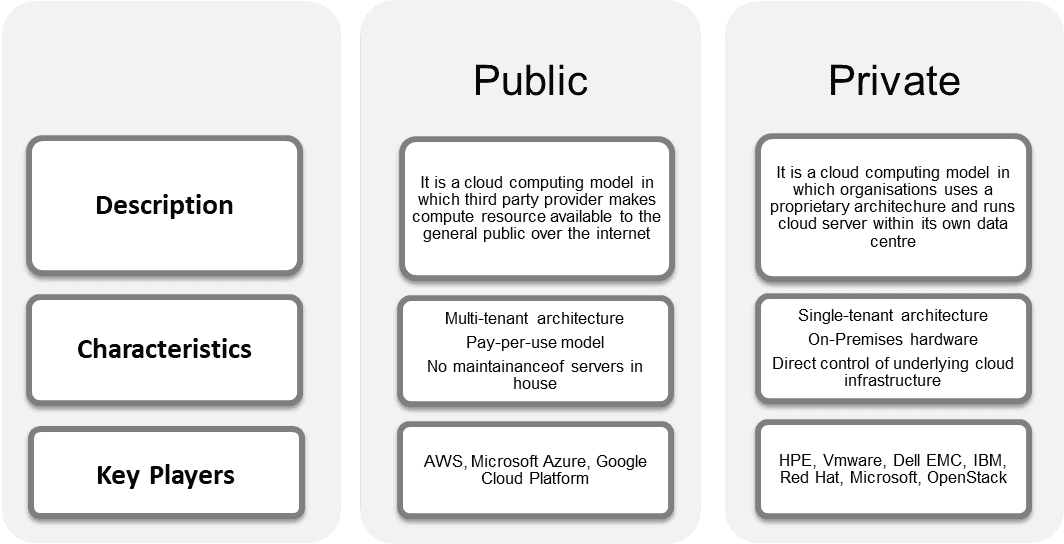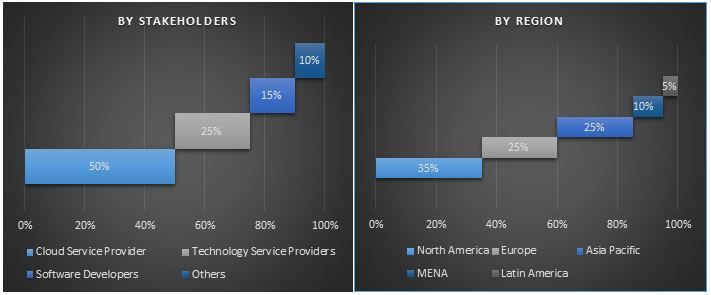- Home
- About Us
- Industry
- Services
- Reading
- Contact Us
Global Market Insights on Cloud Infrastructure: Insights and Forecast, 2018-2024
Emphasis on Deployment Type (Public Cloud, Private Cloud), Public Cloud Services (SaaS, PaaS, IaaS, Cloud Advertising, BPaaS), End User (Banking, Financial Services and Insurance, Retail, Telecom & IT, Healthcare, Media & Entertainment, Government Agencies, Education, Energy, Manufacturing, Other Industries)
Cloud infrastructure, defined as the hardware and software components including servers, storage, network and virtualization software which are used to support the computing requirements of a cloud computing model. To perform day to day work, the companies be it small or big make the use of the cloud infrastructure service which is typically accessed using a pay-per-use model. Cloud service empowers organizations to manage their traditional workload data which is generated on a daily basis. Cloud services give enterprises a competitive edge over their competitor by providing the most innovative technology available to manage their work more efficiently. Users can choose different cloud service option available including public, private or hybrid storage offerings, depending on security needs and other considerations.
Businesses of all sizes deploy huge investing to robust disaster recovery, but for smaller size businesses lack the required cash and expertise, however Cloud service has opened gate for small size companies to manage their data with small investments. According to Aberdeen Group, small businesses are twice as likely as larger companies to implemented cloud service for recovery solutions which ultimately save time, avoid large initial investment and roll up third-party expertise as part of the deal.
Graphical Representation of Cloud Computing Deployment Model Analyzed in the Study
The Global Cloud Infrastructure Market was valued at USD XX billion in 2017, which is expected to grow at a reasonable CAGR of 12% during the analyzed period to reach USD XX billion by 2024. The market witnessed a significant growth due to mobility of data accessibility, trend of big data and analytics, rising demand from organizations for user friendly & cost-effective computing and rise in the number of digital services & their application. However, infrastructure complexity, data security implications, and limited control of cloud resources are the major restraining factors behind the growth of the market.
Growing recognition of economic and operational benefits offered by cloud services has resulted in robust growth potential of the respective model. Usage of cloud computing services has significantly benefitted the organizations and enterprises in terms of cost efficiency. Rising demand for cost effective and flexible IT resources has dramatically fostered the cloud computing services at global scale. Additionally, information technology has witnessed explosive growth over the years. Cloud computing, Big Data and IoT have gained wide prominence and continue to attract huge corporate spending. Global IT spending is anticipated to reach USD XX trillion by 2020 compared to USD 2.18 trillion in 2015. Substantial Surge in adoption of cloud computing service by small and medium enterprises would further provide enormous growth opportunities for the companies operating in the industry.
Insights Presented in the Report:
- The report analyses the cloud Infrastructure service majorly for public and private deployment model. To further add to the analysis the report also segments the market based on cloud infrastructure service, end user industry which is deployed in different country worldwide.
- The report analysis all the potential countries which has showcased increased deployment of cloud service over the last decade. Public and private cloud deployment model is further bifurcated into different services including public cloud (Software as a Service (SaaS), Platform as a Service (PaaS), Infrastructure as a Service (IaaS), Business process as a Service (BPaaS) and cloud advertising. Cloud advertising public cloud services dominated the market in 2016 with a market share of 45.0% and is expected to maintain its dominance during the analyzed period. Private cloud deployment model is segregated into managed hosting and Co-Location.
- The report also analysis the different potential end-user industries who are most frequent adaptor and are most likely to be the likely to be the growth driver for the industry. Banking, Financial Services and Insurance, Retail industry, Telecom & IT, Healthcare, Media & Entertainment, Government agencies, Education, Energy and Manufacturing among others are the major end user industry analyzed during the study. In the Telecom & IT sector huge amount of data are generated owing to this the sector has emerged as the largest adopter of cloud computing, accounted for a market share of 17.7% in 2016 and is expected maintain its dominance during the forecasted period.
- The report further analysis the adoption of cloud service in different geography and countries. Major geography analyzed in the report includes North America (U.S., Canada, and Mexico & Rest of North America), Europe (Germany, U.K., France, Russia, Italy, Spain & Rest of Europe), Asia-Pacific (China, Japan, India, South Korea, Singapore, Australia & Rest of Asia-Pacific) Middle East & North Africa (UAE, Kingdom of Saudi Arabia, Algeria, Egypt, Kuwait, Qatar and Rest of MENA) and Latin America (Brazil, Argentina, Chile and Rest of Latin America). US being the hub of industry is the largest market for cloud computing, which makes North America the dominant region in the adoption of cloud infrastructure with a market share of 48.5% share of the global market in 2016. However, emergence of India and China as manufacturing hub would help the Asia-Pacific region to adopt cloud service a much higher pace compared to other counterparts.
- The report also highlights few prominent players operating in the cloud infrastructure market. Key companies operating the ever-growing cloud infrastructure market includes Cisco System Inc., Equinix Inc., Google Inc., IBM Corporation, Salesforce.com, AT&T Inc., Amazon Web Services Inc., DXC Technology Company, HP Inc., and Rackspace Hosting Inc. These companies have been operating in this sector for several years and have diversified product portfolios, innovative technologies, and strong distribution networks worldwide. Amazon Web Service dominates the cloud market with a market share of 31.0% share, followed by Salesforce and Microsoft.
Reasons to buy the Report:
- The study includes market sizing and forecasting analysis validated by authenticated key industry experts
- The report presents a quick review of overall industry performance at one glance
- The report covers in depth analysis of prominent industry peers with primary focus on key business financials, product portfolio, expansion strategies and recent developments
- Detailed examination on drivers, restraints, key trends and opportunities prevailing in the industry.
- Examination of industry attractiveness with the help of Porter’s Five Forces analysis
- The study comprehensively covers the market across different segments
- Deep dive regional level analysis of the industry
Customization Options:
The Global Cloud Infrastructure Market can be customized to regional/country level or any other market segment. Besides this, UMI understands that you may have your own business need, hence we also provide fully customized solutions to clients.
Table of Content
Analysing historical market, estimation of the current market and forecasting the future market for Global Cloud Infrastructure services market were the three major steps involved in creating and analysing the overall market of the global Cloud Infrastructure Services Market. Exhaustive secondary research was conducted to collect the historical market of the technology and overall estimation of the current market. Secondly, to validate these insights, numerous findings and assumptions were taken into consideration. Moreover, exhaustive primary interviews were conducted with industry experts across value chain of the global Cloud Infrastructure Services Market. After all the assumption, market sizing and validation of market numbers through primary interviews, top-down approach was employed to forecast the complete market size of the global Cloud Infrastructure Services Market. Thereafter, market breakdown and data triangulation methods were adopted to estimate and analyse the market size of segments and sub-segments of the technology. Detailed methodology is explained below:
Analysis of Historical Market Size
Step 1: In-Depth Study of Secondary Sources:
Detail secondary study was conducted to obtain the historical market size of the Global Cloud Infrastructure Services Market through company internal sources such as annual report & financial statements, performance presentations, press releases, inventory records, sales figures etc. and external sources including trade journals, news articles, government publications, competitor publications, sector reports, regulatory bodies publications, safety standard organizations, third-party database and other creditable publications.
Step 2: Market Segmentation:
After obtaining historical market size of the overall market, detailed secondary analysis was done to gather historical market insights and share for different segments & sub-segments for the Global Cloud Infrastructure Services market. Major segments included in the report are public and private deployment model, cloud infrastructure service and end-user industry. Further analysis was also done for sub-segments of the major segments of the Global Cloud Infrastructure Services market.
Step 3: Factor Analysis:
After acquiring the historical market size of different segments and sub-segments, detailed factor analysis was conducted to estimate the current market size of the Global Cloud Infrastructure Services market. Factor analysis was conducted using dependent and independent variable such the preferences of deployment model type i.e. public and private, purchasing power of customers, security concern of data etc. Historical trends of the Global Cloud Infrastructure Services market and its year-on-year impact on the market size and share in the recent past was analyzed. Demand and supply side scenario was also thoroughly studied.
Current Market Size Estimate & Forecast
Current Market Sizing: Based on actionable insights from the above 3 steps, we arrived at current market size, key players in major applications and markets, market shares of these players, industry’s supply chain, and value chain of the industry. All the required percentage shares, splits, and market breakdowns were determined using the above-mentioned secondary approach and were verified through primary interviews.
Estimation & Forecasting: For market estimation and forecast, weightage was assigned to different factors including drivers & trends, restraints, and opportunities. After analyzing these factors, relevant forecasting techniques i.e. Bottom-up/Top-down was applied to arrive at the market forecast pertaining to 2024 for different segment and sub-segments for the technology in major region/country globally. The research methodology adopted to estimate the market size encompasses:
- The industry’s market size, in terms of value (US$) and rate of adoption Cloud Infrastructure services in major region/country globally
- All percentage shares, splits, and breakdowns of market segments and sub-segments
- Key players in major applications and markets as well as market share of each players. Also, the growth strategies adopted by these players to compete in the ever-growing Global Cloud Infrastructure Services market
Market Size and Share Validation
Primary Research: In-depth interviews were conducted with the Key Opinion Leaders (KOLs) including Top Level Executives (CXO/VPs, Sales Head, Marketing Head, Operational Head, and Regional Head etc.). Primary research findings were summarized, and statistical analysis was performed to prove the stated hypothesis. Input from primary research were consolidated with secondary findings, hence turning information into actionable insights.
Split of Primary Participants
Market Engineering
Data triangulation technique was employed to complete the overall market engineering process, to arrive at precise statistical numbers of each segment and sub-segment pertaining to the Global Cloud Infrastructure Services Market. Data was split into several segments & sub-segments post studying various parameters and trends in the areas of Deployment Type i.e. Public or Private deployment. Public Cloud Services i.e., Software as a Service (SaaS), Platform as a Service (PaaS), Infrastructure as a Service (IaaS), Business process as a Service (BPaaS) and Cloud Advertising along with Private Cloud services i.e. Managed Hosting and Co-Location were considered while forecasting the market. Also detailed analysis of the technology in major industrial segment was also considered in the study.
Main objective of the Global Cloud Infrastructure Services Market Study
The current & future market trends of the Global Cloud Infrastructure Services market are pinpointed in the study. Investors can gain strategic insights to base their discretion for investments from the qualitative and quantitative analysis performed in the study. Current and future market trends would determine the overall attractiveness of the market, providing a platform for the industrial participant to exploit the untapped market to benefit as first mover advantage. Other quantitative goal of the studies includes:
- Analyse the current and forecast market size of the Global Cloud Infrastructure Services market in terms of value (US$)
- Analyse the current and forecast market size of different segments and sub-segments of the Cloud Infrastructure Services market globally
- Segments in the study include deployment type, public and private deployment, end-user industry and region
- Define and describe the technologies and protocols used in the Global Cloud Infrastructure Services market
- Anticipate potential risk associated with the technology along with customer and competitor analysis, etc.
- Define and analysis of the government regulations for the global Cloud Infrastructure services market
- Analyse the current and forecast market size of Global Cloud Infrastructure Services market for different region including North America, Europe, Asia-Pacific, MENA and Latin America
- Define and analyse the competitive landscape of the Global Cloud Infrastructure Services market and the growth strategies adopted by the market players to sustain in the ever-growing market
Related Reports
Customers who bought this item also bought












